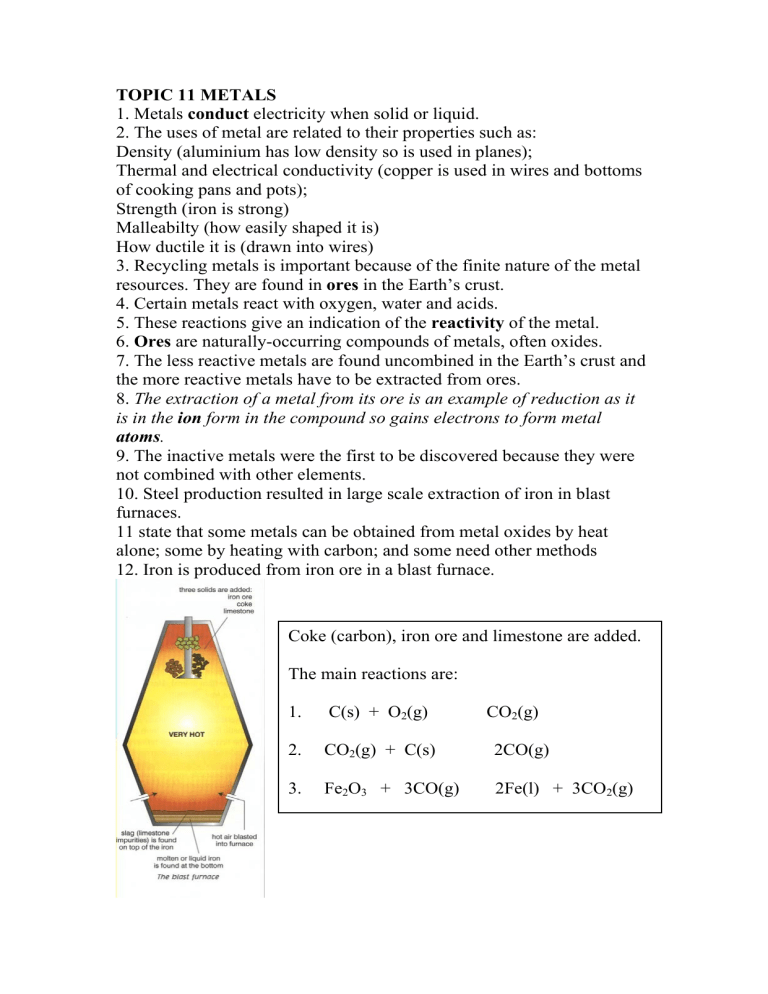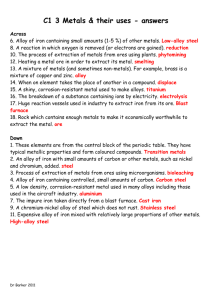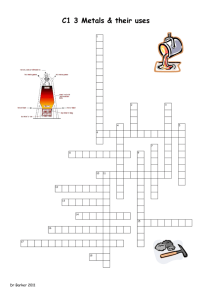TOPIC 11 METALS 1. Metals conduct electricity when solid or liquid

TOPIC 11 METALS
1. Metals conduct electricity when solid or liquid.
2. The uses of metal are related to their properties such as:
Density (aluminium has low density so is used in planes);
Thermal and electrical conductivity (copper is used in wires and bottoms of cooking pans and pots);
Strength (iron is strong)
Malleabilty (how easily shaped it is)
How ductile it is (drawn into wires)
3. Recycling metals is important because of the finite nature of the metal resources. They are found in ores in the Earth’s crust.
4. Certain metals react with oxygen, water and acids.
5. These reactions give an indication of the reactivity of the metal.
6. Ores are naturally-occurring compounds of metals, often oxides.
7. The less reactive metals are found uncombined in the Earth’s crust and the more reactive metals have to be extracted from ores.
8. The extraction of a metal from its ore is an example of reduction as it is in the ion form in the compound so gains electrons to form metal
atoms.
9. The inactive metals were the first to be discovered because they were not combined with other elements.
10. Steel production resulted in large scale extraction of iron in blast furnaces.
11 state that some metals can be obtained from metal oxides by heat alone; some by heating with carbon; and some need other methods
12. Iron is produced from iron ore in a blast furnace.
Coke (carbon), iron ore and limestone are added.
The main reactions are:
1. C(s) + O
2
(g) CO
2
(g)
2. CO
2
(g) + C(s) 2CO(g)
3. Fe
2
O
3
+ 3CO(g) 2Fe(l) + 3CO
2
(g)
13. The two key reactions which take place in the blast furnace: production of carbon monoxide; reduction of iron oxide.
14. An alloy is a mixture of metals, or of metals with non-metals such as carbon for steel. An alloy changes the properties of the metal.
15. Examples of alloys are brass, solder, “stainless steel”.
16. Empirical (or molecular) formulae can be calculated from masses or percentage composition:
Write down the elements in the compound
Write down the mass in the compound of each.
Divide each by their atomic mass to get the number of moles.
Divide each number by the smallest number of moles.
17. Work out percentage masses of elements in compounds from their names or formulae.
Work out the gfm.
For the element in question, divide its mass in the compound by the total gfm and multiply by 100.






